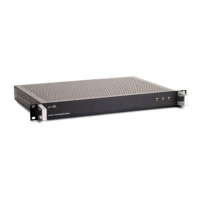EPSILON CLOCK MODEL EC20S Spectracom
31 User’s Manual
10.3 SYNCHRONIZATION SIGNALS DISTRIBUTION
The distribution of the synchronization signals (1PPS, 10MHz) depends on the mute mode (defaulted to
‘Automatic’ mode, see 72 and 73).
In ‘Disabled’ mode, the synchronization signals (1PPS, 10MHz) are ALWAYS delivered (once the
initialization of the EC20S is complete) – but need to meet the SFN condition after start up (see 10.2).
Refer to the diagrams in the following paragraphs.
In ‘Automatic’ mode, the synchronization signals (1PPS, 10MHz) are delivered (once the initialization of
the EC20S is complete) only if the EC20S meets the SFN conditions (i.e. when SFN Status is ‘On’, see
10.2).
In ‘On Time’ mode, the synchronization signals (1PPS, 10MHz) are delivered (once the initialization of
the EC20S is complete) upon timeout conditions defined by 3 parameters 74, 75 and 76 at 13.7.5.
The presence of the distributed synchronization signals (1PPS, 10MHz) is monitored:
- by the ‘DST’ LED (see 11.1),
- by the ALARMS signalling (see 11.2.1),
- Using the web interface: see 13.3.2.7 and 13.3.3,
- Using the SNMP interface: see 14.1.1, SNMP parameters 20 and 21.

